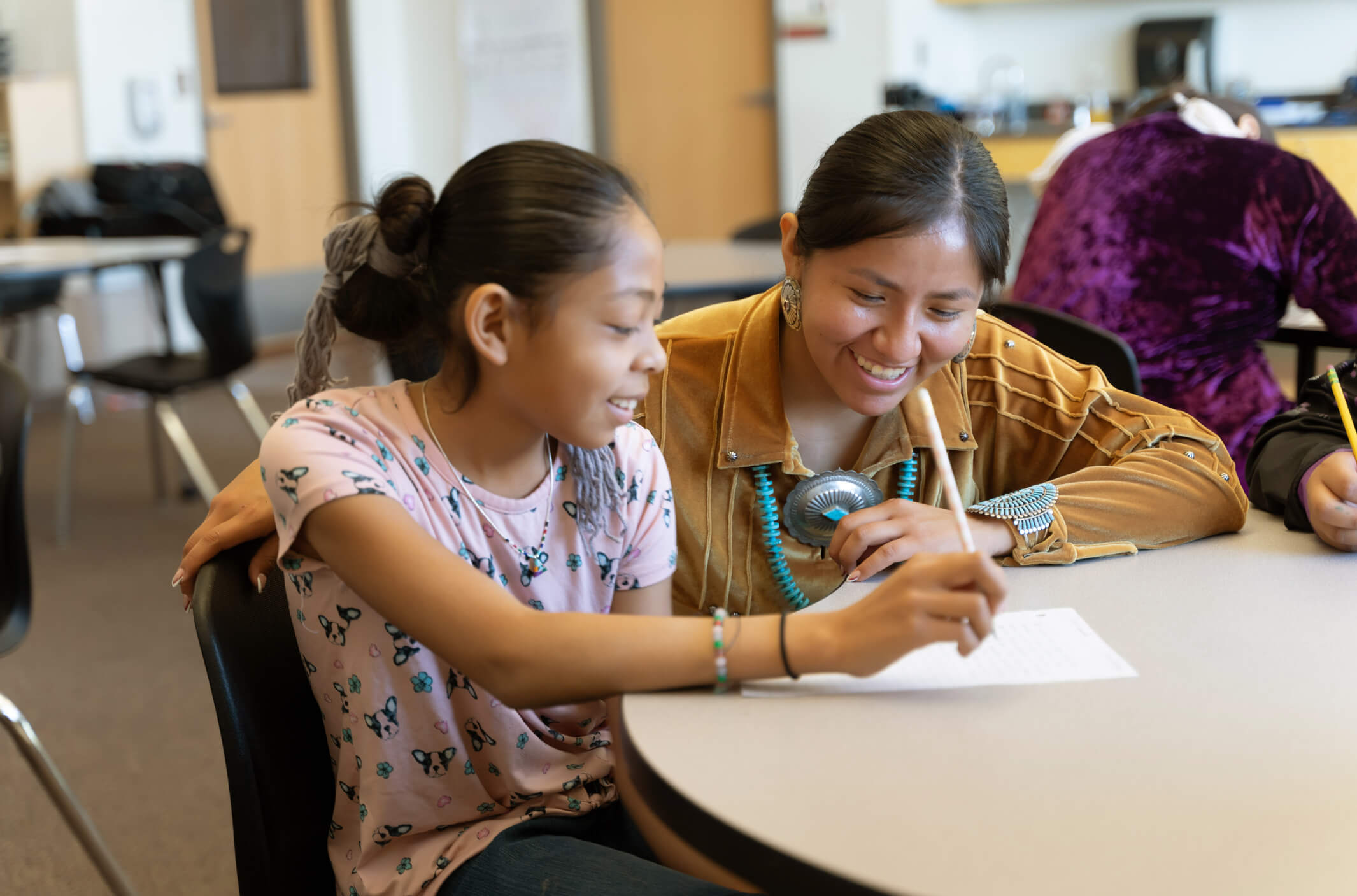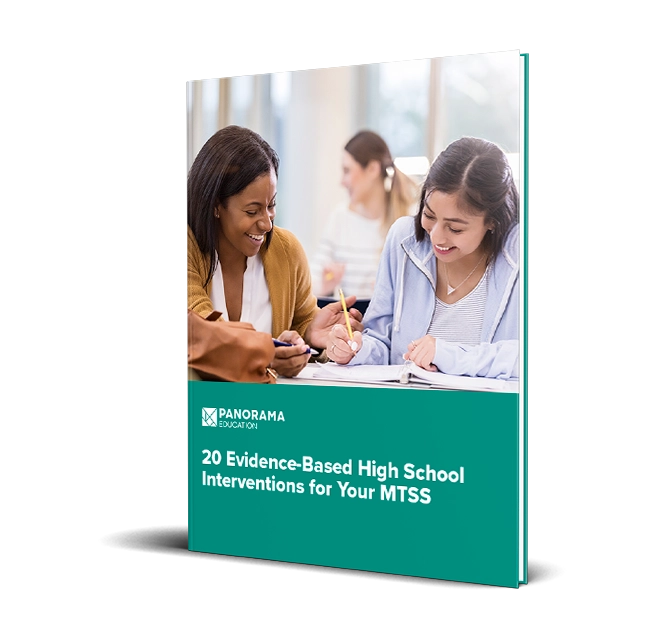A strong multi-tiered systems of support (MTSS) empowers educators to use evidence-based practices to meet the social, behavioral, and academic needs of all students. However, finding evidence-based interventions can be especially challenging for school and district leaders who support high school students.
In fact, a lack of high-quality and engaging programming for secondary school students is a known gap in the broader K-12 education world. Most curricula fail to address the core needs of high school students and instead try to retrofit activities that are designed for younger learners. As a result, many activities can feel inauthentic and miss the mark when it comes to engaging high schoolers.
In this blog, you’ll find 5 evidence-based, engaging, developmentally appropriate MTSS interventions for high school students across attendance and climate, ELA, mathematics, behavior, and life skills.
The interventions have been selected from Playbook, Panorama’s professional learning library for K-12 educators.
|
Districts and schools that partner with Panorama have full access to Playbook, a collection of 800+ strategies, instructional resources, and MTSS interventions across life skills, academics, and behavior. |
Table of Contents
Attendance and Climate: Nudge Letters
Mathematics: Reciprocal Peer Tutoring for Math
Life Skills: Mental Contrasting with Implementation Intentions
|
Key Takeaways:
|
Download 20 free evidence-based high school MTSS interventions
5 Evidence-Based Interventions For High School Students
1. Attendance and Climate: Nudge Letters
(Tier 2, Tier 3)
About This Strategy: Nudge Letters is an intervention focused on communicating about a student’s absenteeism with families. Nudging is an inexpensive and effective means of reducing chronic absenteeism.
Preparation:
- Confirm that current attendance data is accurate.
- Determine family members’ preferred means of contact. Information about the child’s attendance is provided to families through brief postcards, letters, text messages, phone calls, or email.
- Decide when and how frequently families will receive information about their student’s absences. Follow this policy consistently.
Instructions:
- At predetermined intervals or thresholds, send families a message indicating the number of days a student has missed school.
- Include a brief message about the importance of regular school attendance. Provide one way that families can contact the school in response to the message (for example, a phone number or an email address) if so inclined.
2. Behavior: Precorrection
(Tier 2)
About This Strategy: Precorrection is a behavior intervention that can be used to prevent challenging behaviors from occurring. The teacher or support staff member identifies the context in which a problem behavior is likely to occur and then provides prompts and reinforcement for expected social and academic behaviors.
Preparation:
- Print or download the Precorrection checklist.
- Click here to access the facilitator guide.
Instructions:
- Describe the problem behavior and the context (i.e., time, location, activity) that it is likely to occur.
- Identify the expected behavior, with detailed examples.
- Adjust the student’s environment for success. For instance, you might rearrange the classroom or change the seating chart to increase the likelihood that the student will engage in the expected behavior.
- Provide opportunities for the student to practice the expected behavior with you ahead of time.
- Provide strong reinforcement when the student engages in the expected behavior using behavior-specific praise.
- Prompt expected behaviors (e.g., “Jamie, the instructions for the exit ticket are on the board for you to get started working on.”)
- Use data to monitor student progress and make adaptations to procedures as needed.
3. ELA: Semantic Mapping
(Tier 1, Tier 2)
About This Strategy: Semantic Mapping is a process during which readers create a visual tool to make connections among words in a text. The strategy can provide differentiated instruction for language learners, struggling readers, and other students who benefit from a visual display of connections.
Preparation:
- Identify what type of semantic map will be used.
- Decide how students will create the map. This may include: drawing their map, using a provided blank map template, or using an online mapping site or app.
- Print or download materials accordingly, including additional copies for students who want to create multiple maps during reading. You can access a template here.
- Identify any pertinent vocabulary for modeling and practice in a text you will assign for reading.
Instructions:
- Introduce students to semantic maps by explaining that they are tools to build vocabulary knowledge and make connections among words and ideas.
- Display and distribute the web organizer that students will be using. Engage students in a discussion about its different components (center box and the boxes radiating from it), their purpose, and instructions for completing the map.
- Write a word students will encounter in the upcoming text in the center of the map. Read the word aloud, and provide brief instructions on the word’s pronunciation as necessary. Inform students they will work on figuring out the meaning of the word.
- Ask students about any synonyms they know of that relate to the word. Then, write the synonyms in the outer boxes of the web.
- To dig deeper into the word’s meaning, ask a volunteer to help you look up the formal definition. Then, add it to the map.
- Use sketches to illustrate the word’s meaning or show it in action.
- Review the assigned text with students. Then, instruct them to continue adding meanings of the word (using text or illustrations) to the map as they read independently.
- Offer students the opportunity to create additional maps using other unknown words of their choosing from the text.
- Remind students to reread the text (for example, the relevant paragraph or sentence) each time they have completed a map to construct meaning.
4. Mathematics: Reciprocal Peer Tutoring for Math
(Tier 2)
About This Strategy: Peer Tutoring allows students to become teachers. A student follows teacher-created materials as they explain a math concept to a classmate. Roles reverse between students halfway through the activity so all students act as tutors at some point during the activity.
Preparation:
- Prepare teaching materials for tutors to use.
Instructions:
- Model Peer Tutoring for students.
- Assign partners and designate who will be the first tutor in each pair.
- Instruct the tutor to begin using the teaching materials and methods already learned in class to teach the concept to the other student.
- Designate an amount of time or a location in the teaching materials where students will switch roles.
- Monitor students and offer guidance as needed.
- When the designated time ends or as students reach the designated location in the materials, have students switch roles.
- Once again, monitor students and offer guidance as needed.
- Provide feedback to students after the activity.
5. Life Skills: Mental Contrasting With Implementation Intentions (MCII)
(Tier 1)
About This Strategy: This self-regulation strategy is focused on helping students overcome academic challenges.
Preparation:
- Materials: paper, writing utensils
Instructions:
- Prompt students to write down an academic concern or challenge on a piece of paper.
- Example: I’m worried about my upcoming math test.
- Ask students to reflect on this concern and brainstorm possible outcomes. Instruct them to write down the best possible outcomes.
- Example: I get an A on my test and feel proud.
- Example: I get an A on my test and feel proud.
- Have students think through potential obstacles to achieving success. They can write these on the paper.
- Example: The night before my test, I start to watch TV instead of studying.
- Example: The night before my test, I start to watch TV instead of studying.
- Instruct students to write an if/then-when statement. This will both help them through the cues that may lead to the obstacle as well as provide a goal-directed response to overcome it.
- Example: If I feel like watching TV, then I will breathe deeply and shift back to studying.
Using Evidence-Based Interventions for High School Students: Next Steps for School and District Leaders
Ensuring educators have access to high-quality, evidence-based interventions is central to creating a strong MTSS. Consider incorporating these strategies into your district-wide intervention menu. You can also share these resources with your school teams and consider ways to consistently implement interventions districtwide.
School leaders can bring these strategies to PLCs, staff meetings, or MTSS and Student Support team meetings to share with staff and support students at every tier. And teachers and support staff can try these activities in core instruction, with small groups of students, or in individual settings to support the academic, behavioral, and emotional growth of every student.
|
Frequently Asked Questions: 1. How can schools ensure the successful implementation of MTSS interventions in high schools? School and district leaders can ensure successful implementation by providing comprehensive training and professional development opportunities for educators, fostering a culture of collaboration and data-driven decision-making, allocating adequate resources and support for intervention implementation, monitoring fidelity and progress through data analysis, and fostering ongoing communication and feedback loops between schools and district leadership. 2. How can schools measure the effectiveness of MTSS interventions in high schools? District leaders can measure effectiveness through various means, including analyzing academic performance data, tracking changes in behavior and attendance patterns, conducting regular progress monitoring assessments, gathering feedback from educators, students, and families, and assessing the alignment of interventions with identified student needs and outcomes. By employing a comprehensive evaluation framework, district leaders can assess the impact of interventions and make data-informed decisions to drive continuous improvement. 3. What resources are available to support schools in implementing evidence-based MTSS interventions in high schools? School and district leaders can access a variety of resources to support implementation, including professional development opportunities, research-based intervention guides and toolkits, collaboration platforms for sharing best practices and lessons learned, data analysis tools for monitoring progress and fidelity, and support networks such as educational associations and communities of practice. Additionally, partnering with external organizations and experts can provide valuable insights and resources tailored to the unique needs of high school MTSS implementation. |
Download 20 free evidence-based high school interventions for your district's MTSS





![How to Write an Intervention Plan [+ Template]](https://www.panoramaed.com/hubfs/intervention%20planning-1.jpg)

